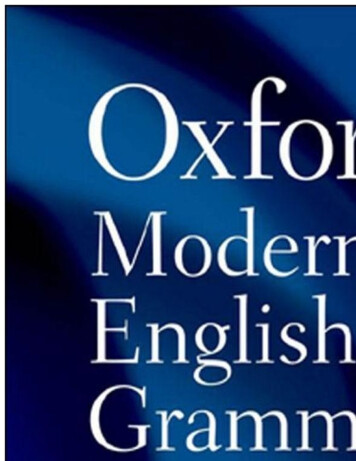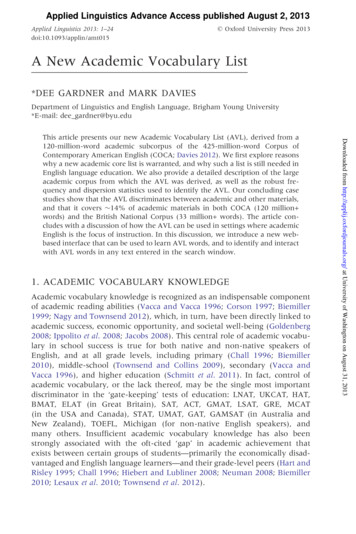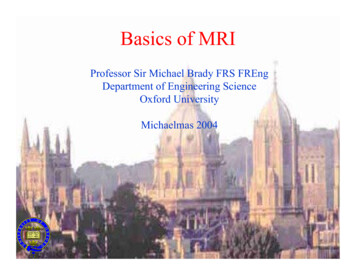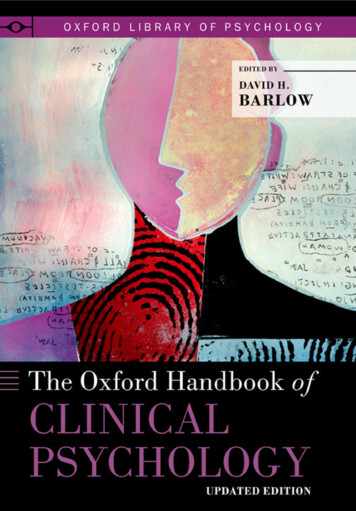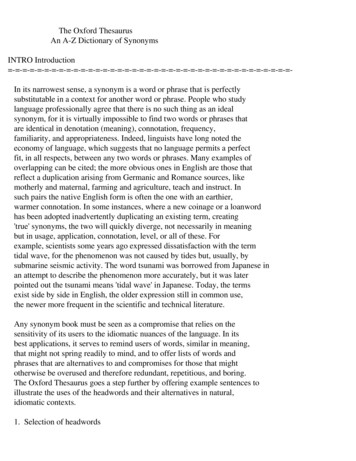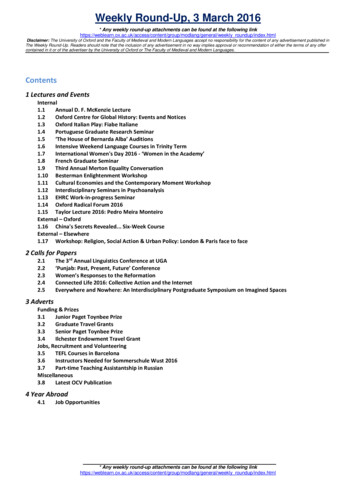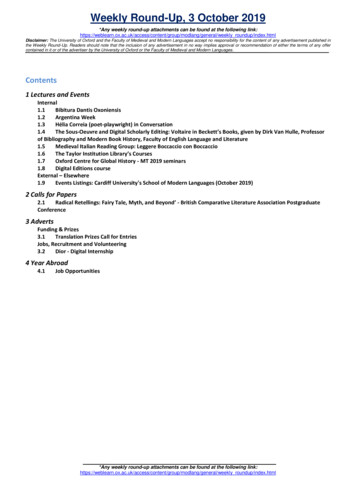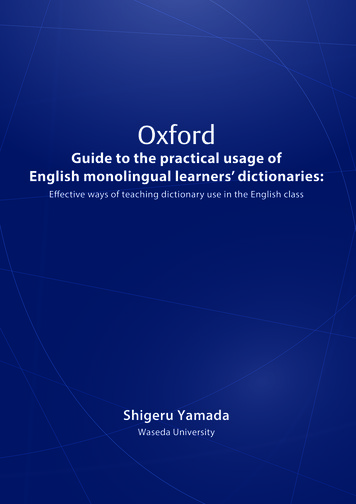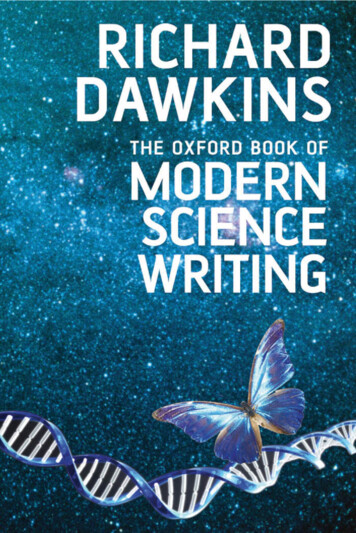
Transcription
The Oxford Book ofMODERN SCIENCE WRITING
This page intentionally left blank
The Oxford Book ofMODERNSCIENCEWRITINGRICHARD DAWKINS1
3Great Clarendon Street, Oxford ox2 6dpOxford University Press is a department of the University of Oxford.It furthers the University’s objective of excellence in research, scholarship,and education by publishing worldwide inOxford New YorkAuckland Cape Town Dar es Salaam Hong Kong KarachiKuala Lumpur Madrid Melbourne Mexico City NairobiNew Delhi Shanghai Taipei TorontoWith offices inArgentina Austria Brazil Chile Czech Republic France GreeceGuatemala Hungary Italy Japan Poland Portugal SingaporeSouth Korea Switzerland Thailand Turkey Ukraine VietnamOxford is a registered trade mark of Oxford University Pressin the UK and in certain other countriesPublished in the United Statesby Oxford University Press Inc., New YorkIntroduction, selection and commentary Richard Dawkins 2008The moral rights of the author have been assertedDatabase right Oxford University Press (maker)First published 2008All rights reserved. No part of this publication may be reproduced,stored in a retrieval system, or transmitted, in any form or by any means,without the prior permission in writing of Oxford University Press,or as expressly permitted by law, or under terms agreed with the appropriatereprographics rights organization. Enquiries concerning reproductionoutside the scope of the above should be sent to the Rights Department,Oxford University Press, at the address aboveYou must not circulate this book in any other binding or coverand you must impose the same condition on any acquirerBritish Library Cataloguing in Publication DataData availableLibrary of Congress Cataloging in Publication DataData availableTypeset by SPI Publisher Services, Pondicherry, IndiaPrinted in Great Britainon acid-free paper byClays Ltd, St Ives plcISBN978–0–19–921680–21 3 5 7 9 10 8 6 4 2
For Charles Simonyi,who loves science, loves language,and understands how to put them together
This page intentionally left blank
CONTENTSxi Featured Writers and Extractsxvii IntroductionPART IWhat Scientists Study341116182227303540James Jeans from THE MYSTERIOUS UNIVERSEMartin Rees from JUST SIX NUMBERSPeter Atkins from CREATION REVISITEDHelena Cronin from THE ANT AND THE PEACOCKR. A. Fisher from THE GENETICAL THEORY OF NATURAL SELECTIONTheodosius Dobzhansky from MANKIND EVOLVINGG. C. Williams from ADAPTATION AND NATURAL SELECTIONFrancis Crick from LIFE ITSELFMatt Ridley from GENOMESydney Brenner ‘THEORETICAL BIOLOGY IN THE THIRDMILLENNIUM’48535961Steve Jones from THE LANGUAGE OF THE GENESJ. B. S. Haldane from ‘ON BEING THE RIGHT SIZE’Mark Ridley from THE EXPLANATION OF ORGANIC DIVERSITYJohn Maynard Smith ‘THE IMPORTANCE OF THE NERVOUSSYSTEM IN THE EVOLUTION OF ANIMAL FLIGHT’66697882868996Fred Hoyle from MAN IN THE UNIVERSED’Arcy Thompson from ON GROWTH AND FORMG. G. Simpson from THE MEANING OF EVOLUTIONRichard Fortey from TRILOBITE!Colin Blakemore from THE MIND MACHINERichard Gregory from MIRRORS IN MINDNicholas Humphrey ‘ONE SELF: A MEDITATION ON THE UNITY OFCONSCIOUSNESS’103 Steven Pinker from THE LANGUAGE INSTINCT and HOW THEMIND WORKS
viii . CONTENTS110 Jared Diamond from THE RISE AND FALL OF THE THIRDCHIMPANZEE114115123127130138143David Lack from THE LIFE OF THE ROBINNiko Tinbergen from CURIOUS NATURALISTSRobert Trivers from SOCIAL EVOLUTIONAlister Hardy from THE OPEN SEARachel Carson from THE SEA AROUND USLoren Eiseley from ‘HOW FLOWERS CHANGED THE WORLD’Edward O. Wilson from THE DIVERSITY OF LIFEPART IIWho Scientists Are151 Arthur Eddington from THE EXPANDING UNIVERSE152 C. P. Snow from the Foreword to G. H. Hardy’s A an Dyson from DISTURBING THE UNIVERSEJ. Robert Oppenheimer from ‘WAR AND THE NATIONS’Max F. Perutz ‘A PASSION FOR CRYSTALS’Barbara and George Gamow ‘SAID RYLE TO HOYLE’J. B. S. Haldane ‘CANCER’S A FUNNY THING’Jacob Bronowski from THE IDENTITY OF MANPeter Medawar from ‘SCIENCE AND LITERATURE, ‘DARWIN’SILLNESS’, ‘THE PHENOMENON OF MAN’, the postscript to‘LUCKY JIM’, and ‘D’ARCY THOMPSON AND GROWTHAND FORM’188190195200211214219226229232234Jonathan Kingdon from SELF-MADE MANRichard Leakey and Roger Lewin from ORIGINS RECONSIDEREDDonald C. Johanson and Maitland A. Edey from LUCYStephen Jay Gould ‘WORM FOR A CENTURY, AND ALL SEASONS’John Tyler Bonner from LIFE CYCLESOliver Sacks from UNCLE TUNGSTENLewis Thomas ‘SEVEN WONDERS’James Watson from AVOID BORING PEOPLEFrancis Crick from WHAT MAD PURSUITLewis Wolpert from THE UNNATURAL NATURE OF SCIENCEJulian Huxley from ESSAYS OF A BIOLOGIST
CONTENTS . ix235 Albert Einstein ‘RELIGION AND SCIENCE’239 Carl Sagan from THE DEMON-HAUNTED WORLDPART IIIWhat Scientists Think247 Richard Feynman from THE CHARACTER OF PHYSICAL LAW249 Erwin Schrödinger from WHAT IS LIFE?254 Daniel Dennett from DARWIN’S DANGEROUS IDEA andCONSCIOUSNESS EXPLAINED259 Ernst Mayr from THE GROWTH OF BIOLOGICAL THOUGHT263 Garrett Hardin from ‘THE TRAGEDY OF THE COMMONS’266 W. D. Hamilton from GEOMETRY FOR THE SELFISH HERD andNARROW ROADS OF GENELAND273 Per Bak from HOW NATURE WORKS276 Martin Gardner THE FANTASTIC COMBINATIONS OF JOHNCONWAY’S NEW SOLITAIRE GAME ‘LIFE’284 Lancelot Hogben from MATHEMATICS FOR THE MILLION289 Ian Stewart from THE MIRACULOUS JAR297 Claude E. Shannon and Warren Weaver from THE MATHEMATICALTHEORY OF COMMUNICATION305 Alan Turing from COMPUTING MACHINERY ANDINTELLIGENCE314317323332336342Albert Einstein from ‘WHAT IS THE THEORY OF RELATIVITY?’George Gamow from MR TOMPKINSPaul Davies from THE GOLDILOCKS ENIGMARussell Stannard from THE TIME AND SPACE OF UNCLE ALBERTBrian Greene from THE ELEGANT UNIVERSEStephen Hawking from A BRIEF HISTORY OF TIMEPART IVWhat Scientists Delight In349 S. Chandrasekhar from TRUTH AND BEAUTY352 G. H. Hardy from A MATHEMATICIAN’S APOLOGY357 Steven Weinberg from DREAMS OF A FINAL THEORY
x . CONTENTS362 Lee Smolin from THE LIFE OF THE COSMOS367 Roger Penrose from THE EMPEROR’S NEW MIND371 Douglas Hofstadter from GÖDEL, ESCHER, BACH: THE ETERNALGOLDEN BRAID378 John Archibald Wheeler with Kenneth Ford from GEONS, BLACKHOLES, AND QUANTUM FOAM381383390392393394David Deutsch from THE FABRIC OF REALITYPrimo Levi from THE PERIODIC TABLERichard Fortey from LIFE: AN UNAUTHORIZED BIOGRAPHYGeorge Gaylord Simpson from THE MEANING OF EVOLUTIONLoren Eiseley from LITTLE MEN AND FLYING SAUCERSCarl Sagan from PALE BLUE DOT397 Acknowledgements401 Index
FEATURED WRITERS AND EXTRACTSAtkins, Peter (1940– ) Chemist and writer. Extract from Creation Revisited,Penguin, 1994.Bak, Per (1948–2002) Theoretical physicist. How Nature Works, OUP, 1997.Blakemore, Colin (1944– ) Neurobiologist. Sight Unseen, BBC books, 1988.Bonner, John Tyler (1920– ) Biologist. Life Cycles: Reflections of an EvolutionaryBiologist, Princeton University Press, 1993.Brenner, Sydney (1927– ) Biologist and Nobel laureate. ‘Theoretical Biology inthe Third Millennium’, Phil. Trans. R. Soc. Lond. B, 354, 1963–1965, 1999.Bronowski, Jacob (1908–1974) Mathematician and broadcaster. The Identity ofMan, Prometheus, 2002. First published 1965.Carson, Rachel (1907–1964) Marine biologist and natural history writer. The SeaAround Us, OUP, 1989. First published 1951.Chandrasekhar, S. (1910–1995) Astrophysicist and Nobel laureate. Truth andBeauty, University of Chicago Press, 1987.Crick, Francis (1916–2004) Molecular biologist and Nobel laureate. What MadPursuit, Basic Books Inc., 1988, and Life Itself, Macdonald and Co, 1981.Cronin, Helena (1942– ) Philosopher of biology. The Ant and the Peacock,Cambridge University Press, 1991.Davies, Paul (1946– ) Cosmologist and science writer. The Goldilocks Enigma,Allen Lane, 2006.Dennett, Daniel C. (1942– ) Philosopher. Consciousness Explained, Penguin, 1993and Darwin’s Dangerous Idea, Penguin, 1996.Deutsch, David (1953– ) Physicist. Fabric of Reality, Penguin, 1997.Diamond, Jared (1937– ) Evolutionary biologist, biogeographer and writer.The Rise and Fall of the Third Chimpanzee, Vintage, 1992.Dobzhansky, Theodosius (1900–1975) Geneticist and evolutionary biologist.Mankind Evolving, Yale University Press, 1962.
xii . FEATURED WRITERS AND EXTRACTSDyson, Freeman (1923– ) Physicist and mathematician. Disturbing the Universe,Pan Books, 1981.Eddington, Sir Arthur (1882–1944) Astrophysicist. The Expanding Universe,Cambridge Penguin, 1940.Edey, Maitland A. (1910–1992) Science writer and conservationist. DonaldC. Johanson and Maitland A. Edey, Lucy: The Beginnings of Humankind,Penguin, 1990. First published 1981.Einstein, Albert (1879–1955) Theoretical physicist and Nobel laureate. Reprintedin Ideas and Opinions, Wings Books, 1954. ‘What is the theory of relativity?’published in The London Times, 1919. ‘Religion and Science’ published in theNew York Times Magazine, 1930.Eiseley, Loren (1907–1977) Anthropologist, ecologist and writer. ‘How Flow-ers Changed the World’ and ‘Little Men and Flying Saucers’, in The ImmenseJourney, Vintage, 1957.Feynman, Richard P. (1918–1988) Theoretical physicist and Nobel laureate.The Character of Physical Law, Penguin, 1992.Fisher, Sir Ronald (1890–1962) Statistician, evolutionary biologist and geneticist.The Genetical Theory of Natural Selection, OUP, 2006.Ford, Kenneth (1926– ) Physicist. John Archibald Wheeler and Kenneth Ford,Geons, Black Holes and Quantum Foam: a life in physics, WW Norton, 1998.Fortey, Richard (1946– ) Palaeontologist. Trilobite!, Flamingo, 2001. Originallypublished 2000. Life: an Unauthorised Biography, Flamingo, 1998.Gamow, George (1904–1968) Theoretical physicist and cosmologist. Mr Tompkinsin Paperback, Cambridge University Press, 1993. Mr Tomkins in Wonderland firstpublished 1940.Gardner, Martin (1914– ) Mathematics and Science Writer. ‘MathematicalGames’ column, Scientific American 223, October 1970.Gould, Stephen Jay (1941–2002) Palaeontologist, evolutionary biologist andwriter. ‘Worm for a Century and All Seasons’, in Hen’s Teeth and Horse’s Toes,W W Norton & Co., 1983.Greene, Brian (1963– ) Theoretical Physicist. The Elegant Universe, Vintage, 2000.Gregory, Richard (1923– ) Neuropsychologist. Mirrors in Mind, W. H. Freeman& Co. Ltd, 1997.Haldane, J. B. S. (1892–1964) Geneticist and evolutionary biologist. On Being theRight Size and Other Essays, Oxford University Press, 1991, formerly publishedin Possible Worlds and Other Essays, Chatto & Windus, 1927. ‘Cancer’s a FunnyThing’, New Statesman, 1964.Hamilton, W. D. (1936–2000) Evolutionary biologist. ‘Geometry for the SelfishHerd’, Journal of Theoretical Biology, 31, 295–311, reprinted in Narrow Roads ofGene Land, Vol. 1. W. H. Freeman, 1996.
FEATURED WRITERS AND EXTRACTS . xiiiHardin, Garrett (1915–2003) Ecologist. ‘The Tragedy of the Commons’, Science,162, No. 3859, 1243–48, 1968.Hardy, Alister (1896–1985) Marine biologist. The Open Sea: Its Natural History,Part 1: The World of Plankton. Collins, 1970. First published 1956.Hardy, G.H. (1877–1947) Mathematician. A Mathematician’s Apology, CambridgeUniversity Press, 2007. First published 1940.Hawking, Stephen (1942– ) Theoretical physicist. A Brief History of Time, BantamBooks, 1988.Hofstadter, Douglas R. (1945– ) Cognitive scientist, philosopher, polymath,Pulitzer Prize-winning author. Godel, Escher, Bach, Basic Books, 1979.Hogben, Lancelot (1895–1975) Zoologist and statistician. Mathematics for theMillion, Norton, 1993. Originally published 1937.Hoyle, Fred (1915–2001) Astronomer and writer. Man in the Universe, ColumbiaUniversity Press, 1966.Humphrey, Nicholas (1943– ) Psychologist. ‘One Self’, in The Mind Made Flesh,Oxford University Press, 2002. First published in Social Research, 67, 32–39, 2000.Huxley, Julian (1887–1975) Evolutionary biologist. Essays of a Biologist, Chatto &Windus, 1929. First published 1923.Jeans, James (1877–1946) Physicist, astronomer and mathematician. The MysteriousUniverse, Cambridge University Press, 1930.Johanson, Donald C. (1943– ) Palaeoanthropologist. Donald C. Johanson andMaitland A. Edey, Lucy: The Beginnings of Humankind, Penguin, 1990.Jones, Steve (1944– ) Geneticist and writer. The Language of Genes, Flamingo, 2000.Kingdon, Jonathan (1935– ) Biologist, artist, and writer. Before the Wise Men,Simon and Schuster, 1993.Lack, David (1910–1973) Ornithologist. The Life of the Robin, Collins, 1965.Leakey, Richard (1944– ) Palaeoanthropologist and conservationist. RichardLeakey and Roger Lewin, Origins Reconsidered, Little, Brown, 1992.Levi, Primo (1919–1987) Chemist and writer. The Periodic Table, Penguin Classics,2000. This translation, by Raymond Rosenthal, first published by Shocken Books,1984.Lewin, Roger Anthropologist and science writer. Richard Leakey and RogerLewin, Origins Reconsidered, Little, Brown, 1992.Maynard Smith, John (1920–2004) Evolutionary biologist and geneticist. OnEvolution, Edinburgh University Press, 1972.Mayr, Ernst (1904–2005) Evolutionary biologist. The Growth of BiologicalThought, Harvard University Press, 1982.Medawar, Peter B. (1915–1987) Medical scientist and writer, Nobel laureate.‘Science and Literature’ from The Hope of Progress, Wildwood House, 1974;
xiv . FEATURED WRITERS AND EXTRACTS‘Darwin’s Illness’, ‘The Phenomenon of Man’, and the postscript to ‘Lucky Jim’from The Strange Case of the Spotted Mice, Oxford University Press, 1996; ‘D’ArcyThompson and Growth and Form’ from The Art of the Soluble, Penguin, 1969.Oppenheimer, J. Robert (1904–1967) Theoretical physicist. The Flying Trapeze:three crisis for physicists, Oxford University Press, 1964.Penrose, Roger (1931– ) Mathematical Physicist. The Emperor’s New Mind,Oxford University Press, 1989.Perutz, Max (1914–2002) Molecular biologist. ‘A Passion for Crystals’, in I WishI’d Made You Angry Earlier, Oxford University Press, 1998. First published asan obituary in The Independent, 1994.Pinker, Steven (1954– ) Psychologist, cognitive scientist and writer. How TheMind Works, Allen Lane, 1997 and The Language Instinct, Allen Lane, 1994.Rees, Martin (1942– ) Cosmologist and writer. Just Six Numbers, Phoenix, 2000.Ridley, Mark (1956– ) Zoologist and science writer. The Explanation of OrganicDiversity, Clarendon Press, 1983.Ridley, Matt (1958– ) Zoologist and science writer. Genome, Fourth Estate, 1999.Sacks, Oliver (1933– ) Neurologist and writer. Uncle Tungsten, Picador, 2001.Sagan, Carl (1934–1996) Astronomer and writer. Pale Blue Dot, Ballantine, 1997.Schrodinger, Erwin (1887–1961) Physicist and Nobel laureate. What is Life?,Cambridge University Press, 2000. First published 1944.Shannon, Claude (1916–2001) Electrical engineer and mathematician. ClaudeShannon and Warren Weaver, The Mathematical Theory of Communication,University of Illinois Press, 1980. Originally published 1949.Simpson, George Gaylord (1902–1984) Palaeontologist. Meaning of Evolution,Yale University Press, 1963. First published 1949.Smolin, Lee (1955– ) Theoretical physicist. The Life of the Cosmos, Phoenix, 1997.Snow, C.P. (1905–1980) Physicist and novelist. G.H. Hardy’s A Mathematician’sApology (Foreword), Cambridge University Press, 1967.Stannard, Russell (1931– ) Physicist and writer. The Time and Space of UncleAlbert, Faber and Faber, 1989.Stewart, Ian (1945– ) Mathematician and writer. From Here to Infinity, OxfordUniversity Press, 1996. First published as The Problems of Mathematics, 1987.Thomas, Lewis (1913–1993) Physician and essayist. Late Night Thoughts, OxfordUniversity Press, 1985. First published 1980.Thompson, D’Arcy Wentworth (1860–1948) Biologist and classicist. On Growth andForm, Cambridge University Press, 2004. Original complete work published 1917.Tinbergen, Niko (1907–1988) Ethologist, ornithologist and Nobel laureate. CuriousNaturalists, Country Life, 1958.
FEATURED WRITERS AND EXTRACTS . xvTrivers, Robert (1943– ) Evolutionary biologist. Social Evolution, Benjamin-Cummings Publishing Co, 1985.Turing, Alan (1912–1954) Mathematician. Computing Machinery and Intelligence,Mind, 59, 1950.Watson, James (1928– ) Molecular biologist and Nobel laureate. Avoid BoringPeople, Oxford University Press, 2007.Weaver, Warren (1894–1978) Mathematician and scientist. Claude Shannon andWarren Weaver, The Mathematical Theory of Communication, University ofIllinois Press, 1980. Originally published 1949.Weinberg, Steven (1933– ) Theoretical physicist and Nobel laureate. Dreams ofa Final Theory, Vintage, 1993.Wheeler, John Archibald (1911– ) Theoretical physicist. John Archibald Wheelerand Kenneth Ford, Geons, Black Holes and Quantum Foam, WW Norton, 1998.Williams, George C. (1926– ) Evolutionary biologist. Adaptation and NaturalSelection, Princeton University Press, 1966.Wilson, Edward O. (1929– ) Biologist. The Diversity of Life, Penguin, 2001.Wolpert, Lewis (1929– ) Developmental biologist and writer. The UnnaturalNature of Science, Faber and Faber, 1992.
This page intentionally left blank
INTRODUCTION My introductory remarks are distributed through the book itself, soI shall here limit myself mostly to acknowledgements. The idea for an anthology of modern science writing was put to me by Latha Menon of Oxford University Press, and it was a pleasure to work with her on it. Sheand I had previously collaborated on a collection of my own occasionalwritings, and we slipped effortlessly back into the same synoptic vein asbefore. We disagreed only over whether or not to include anything frommy own books. I won, and we didn’t.This is a collection of good writing by professional scientists, not excursions into science by professional writers. Another difference from JohnCarey’s admirable Faber Book of Science is that we go back only one century.Within that century, no attempt was made to arrange the pieces chronologically. Instead, the selections fall roughly into four themes, although someof the entries could have fitted into more than one of these divisions. Mybiggest regret concerns the number of excellent scientists that I have had toleave out, for reasons of space. I would apologize to them, did I not suspectthat my own pain at their omission is greater than theirs. The collection islimited to the English language and, with very few exceptions, I have omitted translations from books originally composed in other languages.My wife, Lalla Ward, has again lent her finely tuned ear for the English language, together with her unfailing encouragement. I remain deeplygrateful to her.I have long wanted to dedicate a book to Charles Simonyi, but I was anxious to be clear that it was a dedication to him as an individual and friend,rather than as the munificent benefactor of the Oxford professorship inPublic Understanding of Science that I hold. Now, in the year of my retirement, it finally seems appropriate to offer this volume to him as a personalfriend, while at the same time conveying Oxford’s gratitude to a major
xviii . INTRODUCTIONbenefactor through a book published by the University Press. Charles Simonyi is a sort of combination of International Renaissance Man, Playboyof the Scientific World, Test Pilot of the Intellect, and Space-age Orbiterof the Mind as well as of the Planet. Although most of the words in ananthology belong to others, I hope that my love of science and of writing,which Charles shares and which he generously chose to encourage in me,will shine through both my selections and my commentary, and give himpleasure. Richard DawkinsOxford, September 2007
PART IWHATSCIENTISTSSTUDY
This page intentionally left blank
James Jeansfrom T HE MYS T ERIOUS UNIVERSE Our ability to understand the universe and our position in it is oneof the glories of the human species. Our ability to link mind to mind bylanguage, and especially to transmit our thoughts across the centuries isanother. Science and literature, then, are the two achievements of Homosapiens that most convincingly justify the specific name. In attempting,however inadequately, to bring the two together, this book can be seenas a celebration of humanity. It is only superficially paradoxical to beginour celebration by cutting humanity down to size, and no science puts usin our place better than astronomy. I begin with a fragment from JamesJeans’s 1930 book, The Mysterious Universe, which is a fine example of thehumbling prose poetry that the stars so intoxicatingly inspire. Standing on our microscopic fragment of a grain of sand, we attempt todiscover the nature and purpose of the universe which surrounds ourhome in space and time. Our first impression is something akin to terror. We find the universe terrifying because of its vast meaningless distances, terrifying because of its inconceivably long vistas of time whichdwarf human history to the twinkling of an eye, terrifying because ofour extreme loneliness, and because of the material insignificance ofour home in space—a millionth part of a grain of sand out of all thesea-sand in the world. But above all else, we find the universe terrifyingbecause it appears to be indifferent to life like our own; emotion, ambition and achievement, art and religion all seem equally foreign to itsplan. Perhaps indeed we ought to say it appears to be actively hostile tolife like our own. For the most part, empty space is so cold that all life init would be frozen; most of the matter in space is so hot as to make lifeon it impossible; space is traversed, and astronomical bodies continuallybombarded, by radiation of a variety of kinds, much of which is probably inimical to, or even destructive of, life.
4 . WHAT SCIENTISTS STUDYInto such a universe we have stumbled, if not exactly by mistake, atleast as the result of what may properly be described as an accident. Theuse of such a word need not imply any surprise that our earth exists, foraccidents will happen, and if the universe goes on for long enough, everyconceivable accident is likely to happen in time. It was, I think, Huxleywho said that six monkeys, set to strum unintelligently on typewritersfor millions of millions of years, would be bound in time to write allthe books in the British Museum. If we examined the last page whicha particular monkey had typed, and found that it had chanced, in itsblind strumming, to type a Shakespeare sonnet, we should rightly regard the occurrence as a remarkable accident, but if we looked throughall the millions of pages the monkeys had turned off in untold millionsof years, we might be sure of finding a Shakespeare sonnet somewhereamongst them, the product of the blind play of chance.Martin Reesfrom J U S T S IX NUMBERS As Astronomer Royal and President of the Royal Society, Martin Rees,too, is no stranger to the romance of the stars and of science. His approachto putting us in our place invokes the mythical symbol of the ouraborusto situate us exactly in the middle of the (logarithmic) spectrum of magnitudes ranging from the astronomical to the sub-atomic. I shall revertto this later in the book, when I discuss the difficulties experienced by theevolved human mind as we try to understand the extreme realms of science far from the middle ground in which our ancestors survived.The first extract comes from Rees’s 1999 book Just Six Numbers. A secondextract from the same book explains its central theme. Modern physics hasmade amazing strides towards explaining the universe, heroically drivingour ignorance back into the first fraction of a second after the Big Bang.But our explanations of the deep problems of existence rely on some half
MARTIN REES . 5dozen numbers, the fundamental constants of physics, whose values wecan measure but cannot derive from existing theories. They are just there;and many physicists, including Rees himself (though not, for example, Victor Stenger, a physicist for whom I also have a very high regard) believethat their precise values are crucial to the existence of a universe capableof producing biological evolution of some kind. Rees takes each of the sixconstants in turn, and the one I have chosen for this anthology is N, theratio between the strength of the electrical force that holds atoms togetherand the gravitational force that holds the universe together. Large Numbers and Diverse ScalesWe are each made up of between 1028 and 1029 atoms. This ‘human scale’is, in a numerical sense, poised midway between the masses of atoms andstars. It would take roughly as many human bodies to make up the massof the Sun as there are atoms in each of us. But our Sun is just an ordinary star in the galaxy that contains a hundred billion stars altogether.There are at least as many galaxies in our observable universe as there arestars in a galaxy. More than 1078 atoms lie within range of our telescope.Living organisms are configured into layer upon layer of complex structure. Atoms are assembled into complex molecules; these react, via complexpathways in every cell, and indirectly lead to the entire interconnected structure that makes up a tree, an insect or a human. We straddle the cosmos andthe microworld—intermediate in size between the Sun, at a billion metresin diameter, and a molecule at a billionth of a metre. It is actually no coincidence that nature attains its maximum complexity on this intermediatescale: anything larger, if it were on a habitable planet, would be vulnerableto breakage or crushing by gravity.We are used to the idea that we are moulded by the microworld:we are vulnerable to viruses a millionth of a metre in length, and theminute DNA double-helix molecule encodes our total genetic heritage.And it’s just as obvious that we depend on the Sun and its power. Butwhat about the still vaster scales? Even the nearest stars are millions oftimes further away than the Sun, and the known cosmos extends a billion times further still. Can we understand why there is so much beyond
6 . WHAT SCIENTISTS STUDYour Solar System? In this book I shall describe several ways in which weare linked to the stars, arguing that we cannot understand our originswithout the cosmic context.The intimate connections between the ‘inner space’ of the subatomicworld and the ‘outer space’ of the cosmos are illustrated by the picturein Figure 1—an ouraborus, described by Encyclopaedia Britannica as the‘emblematic serpent of ancient Egypt and Greece, represented with itstail in its mouth continually devouring itself and being reborn from itself . . . [It] expresses the unity of all things, material and spiritual, whichnever disappear but perpetually change form in an eternal cycle of destruction and re-creation’.On the left in the illustration are the atoms and subatomic particles; thisis the ‘quantum world’. On the right are planets, stars and galaxies. This bookwill highlight some remarkable interconnections between the microscaleson the left and the macroworld on the right. Our everyday world is determined by atoms and how they combine together into molecules, minerals1025 cm10 20 cm1020 cm10 15 cm1015 cm10 10 cm1010 cm10 5 cm105 cmFigure 1. The ouraborus. There are links between the microworld of particles,nuclei and atoms (left) and the cosmos (right).
MARTIN REES . 7and living cells. The way stars shine depends on the nuclei within thoseatoms. Galaxies may be held together by the gravity of a huge swarm ofsubnuclear particles. Symbolized ‘gastronomically’ at the top, is the ultimatesynthesis that still eludes us—between the cosmos and the quantum.Lengths spanning sixty powers of ten are depicted in the ouraborus.Such an enormous range is actually a prerequisite for an ‘interesting’ universe. A universe that didn’t involve large numbers could never evolve acomplex hierarchy of structures: it would be dull, and certainly not habitable. And there must be long timespans as well. Processes in an atommay take a millionth of a billionth of a second to be completed; withinthe central nucleus of each atom, events are even faster. The complexprocesses that transform an embryo into blood, bone and flesh involve asuccession of cell divisions, coupled with differentiation, each involvingthousands of intricately orchestrated regroupings and replications ofmolecules; this activity never ceases as long as we eat and breathe. Andour life is just one generation in humankind’s evolution, an episode thatis itself just one stage in the emergence of the totality of life.The tremendous timespans involved in evolution offer a new perspective on the question ‘Why is our universe so big?’ The emergence ofhuman life here on Earth has taken 4.5 billion years. Even before our Sunand its planets could form, earlier stars must have transmuted pristinehydrogen into carbon, oxygen and the other atoms of the periodic table.This has taken about ten billion years. The size of the observable universeis, roughly, the distance travelled by light since the Big Bang, and so thepresent visible universe must be around ten billion light-years across.This is a startling conclusion. The very hugeness of our universe,which seems at first to signify how unimportant we are in the cosmicscheme, is actually entailed by our existence! This is not to say that therecouldn’t have been a smaller universe, only that we could not have existed in it. The expanse of cosmic space is not an extravagant superfluity; it’s a consequence of the prolonged chain of events, extending backbefore our Solar System formed, that preceded our arrival on the scene.This may seem a regression to an ancient ‘anthropocentric’ perspective—something that was shattered by Copernicus’s revelation that the Earthmoves around the Sun rather than vice versa. But we shouldn’t takeCopernican modesty (sometimes called the ‘principle of mediocrity’) too
8 . WHAT SCIENTISTS STUDYfar. Creatures like us require special conditions to have evolved, so ourperspective is bound to be in some sense atypical. The vastness of ouruniverse shouldn’t surprise us, even though we may still seek a deeperexplanation for its distinctive features.[. . .]The Value of N and Why it is So LargeDespite its importance for us, for our biosphere, and for the
Richard Leakey and Roger Lewin, Origins Reconsidered, Little, Brown, 1992. Levi, Primo (1919–1987) Chemist and writer. The Periodic Table, Penguin Classics, 2000. This translation, by Raymond Rosenthal, fi rst published by Shocken Books, 1984. Lewin, Roger Anthropologist and


